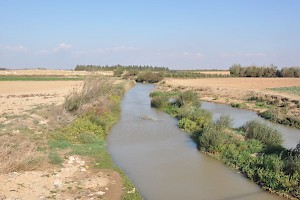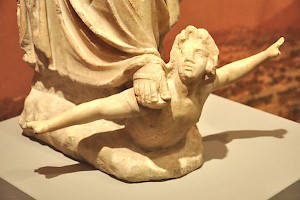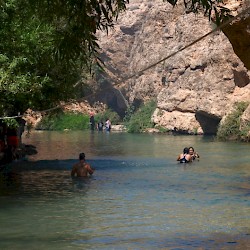Orontes (Nahr al-Asi)
Q188871Orontes: river in Syria, modern Nahr al-Asi.

The Orontes is one of the most famous rivers of Antiquity. Its source is in the valley between the Lebanon and the Anti-Lebanon,note not far from Hermel, which is just north of Baalbek-Heliopolis. This was a sacred place; the remains of a Maronite monastery prove that it was still recognized as holy in the Byzantine period.
According to Strabo, the river used to flow underground for a while, but resurfaced.note Brooks from both mountain ranges feed the river, which flows for about 400 kilometer in a generally northern direction, keeping the Bargylus Mountains to its left, and never becomes very large. Still, it is a pretty substantial stream that is navigable with rafts and can also be used to irrigate the land.

Among the cities along the river are Laodicea near the Lebanon, Emesa (modern Homs; famous for its cult of Elagabal), Hama (still well-known for its watermills), and Apamea, which is at about two thirds of the rivers' entire course. Here, the landscape opens up and the river flows through a wide, fertile plain, which is dominated by Tell Kadesh.
When the Orontes has reached its main tributuary, the river now called Afrin, it turns to the southwest; in its last fifty kilometer, it passes Antioch, where it becomes navigable for ships. It finally empties itself into the Mediterranean Sea just south of Seleucia.

According to Strabo, an Aramaean myth stated that the river used to be called after Typhon, a dragon, who had once been struck by a bolt of lightning and had fled underground, cutting the earth and forming the bed of the river, and finally causing the fountain to break forth to the surface.note Later, Strabo adds (without mentioning the source of this second statement), the river was called Orontes after a man who built a bridge across it.
There is no reason to doubt that the Aramaeans told stories about dragons, and the association with lighting is particularly striking, because close to the source was the sanctuary of the thundering god of Baalbek. The story about the renaming, on the other hand, sounds like a Greek explanation of a river name that sounded like a Greek person's name.

The wide valley of the middle Orontes is not only extremely fertile, it is also flat, so that armies can easily encounter each other. The river has seen many military engagements. The most famous of these is the Battle of Kadesh in 1274 BCE, in which the armies of the Hittite king Muwatalli II and pharaoh Ramesses II clashed; the latter won a tactical victory, but had to admit that the valley was taken over by the Hittites.
The Antakya Stela documents how the Assyrian king Adad-Nirari III (810-783) intervened in a conflict between two local rulers, Ataršumki of Arpad (near Aleppo) and Zakkur of Hamath (modern Hama), and decided that the first-mentioned received a tract of land along the river. In 609, pharaoh Necho II used Riblah on the Orontes as base for his war to support the Assyrian king Aššur-Uballit II. Three centuries later, the successors of Alexander the Great came together at Triparadisus, perhaps at Baalbek, to divide the Empire (more...).

In c.300, the city of Antioch was founded on the Lower Orontes. The river was depicted on the famous statue of the Tyche of Antioch, the city's good fortune, carved by Eutychides of Sicyon. Upstream, Apamea was founded, while the land along the river was used by the Seleucid kings as a zoo for their war elephants.note
Because much of ancient historiography deals with military matters, the Orontes became well-known At the end of the first century CE, the Roman poet Juvenal described a xenophobe who feared "that the Orontes was emptying itself into the Tiber", meaning that too many Asians had come to live in Rome.note There was no need to explain where this river was - any Roman reader knew it, and it could be used as pars pro toto for Asia.
 Orontes, Source |
 Orontes, Source, Monastery |